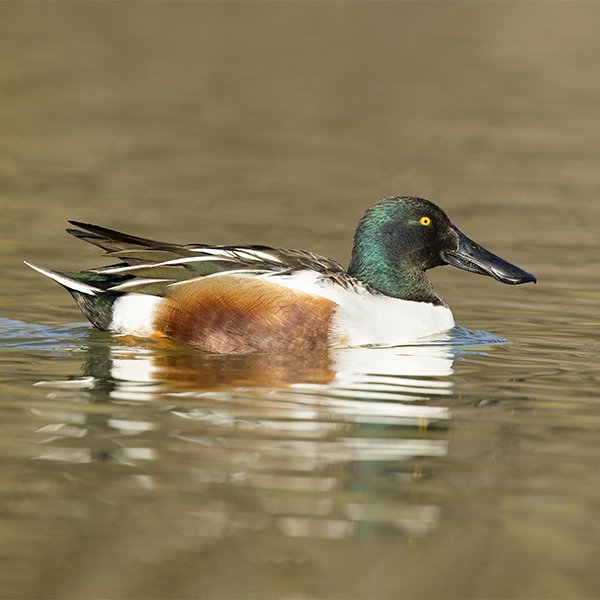Bird of the Month: Northern Shoveler
Written by Andy McCormick
Andy McCormick, Volunteer and Former Board President of Eastside Audubon
The Northern Shoveler breeds in Eastern Washington and winters in Western Washington.
The most outstanding feature of the Northern Shoveler is its large spatulate bill which is so prominent that the duck’s identity is unmistakable. As a beginning birder I was amazed when a more experienced birder identified a group of Northern Shovelers while they had their heads submerged! He explained that shovelers feed head down and that they often form a group and spin around with their heads under water to stir up small plants, insects, small crustaceans, and invertebrates which they then sift out with hair-like linings on their wide bill. Excellent videos of foraging shovelers can be viewed at The Macaulay Library.
From September through May the male Northern Shoveler is in breeding plumage and its green head, white chest, and rufous sides present a striking mix of color. The white chest is a good field mark. The Northern Pintail (Anas acuta) is the only other North American duck with a white chest. The female shoveler has the same large bill, but its plumage is like the female Mallard. An important difference shows in the wide pale edges on the tertials (inner flight feathers) noticeable toward the rear of the bird when the wing is folded.
GENUS SPATULA
After mitochondrial DNA testing was conducted on ducks in the genus Anas researchers found four subgroupings. For ducks like the shoveler the American Ornithological Society resurrected the genus Spatula, which is Latin for spoon referring to the spoon-shaped bills of many of the 10 species of ducks that were placed into it (Wikipedia). The Blue-winged (S. discors) and Cinnamon (S. cyanoptera) Teals and the Garganey (S. querquedula) are the other three North American species included in the genus. The other six species are found in Africa and Asia.
The species epithet of the Northern Shoveler also relates to its bill. The Latin clypeus means shield and some people referred to the bill as shield-shaped (Holloway). The English name shoveler also refers to the bill, which it uses to root out water plants while foraging.
Northern Shoveler
Scientific Name: Spatula clypeata
Length: 19”
Wingspan: 30”
Weight: 131.3 lb (610g)
AOU Alpha Code: NSHO
MARSH AND POND DUCK
Shovelers seek out similar pond and marsh habitats in both summer and winter but are not hardy in colder weather. They migrate north later than most dabbling ducks arriving on the breeding grounds in mid-May and withdraw south by September (Dubowy, et al). The center of the North American breeding range of the Northern Shoveler is in the prairie potholes region of the north-central United States and south-central Canada. This area is so highly productive that Ducks Unlimited calls it the “duck factory.” Shovelers are hunted but some think they are not very edible and hence hunters tend to avoid them.
Shovelers nest near water but on dry land in grassy areas. The nest is a shallow depression of grass lined with down. Usually, 8 to 11 eggs are deposited, and they hatch in a little over three weeks. The hatchlings leave the nest shortly after hatching and forage for their own food right away (Kaufman).
STATUS AND DISTRIBUTION
The Northern Shoveler nests in the middle northern latitudes around most of the globe. However, they do not breed in much of eastern Canada. The species has enjoyed long-term stability in its population, which in North America is about 3,000,000 individuals. Another 2,000,000 shovelers have been counted on other continents. One theory supporting these numbers is that the shoveler’s specialized bill and unique foraging ecology may help it survive better than other dabbling ducks during times of reduced food availability in winter (Dubowy, et al).
Photo credit Mick Thompson. References available upon request from amccormick@eastsideaudubon.org.



